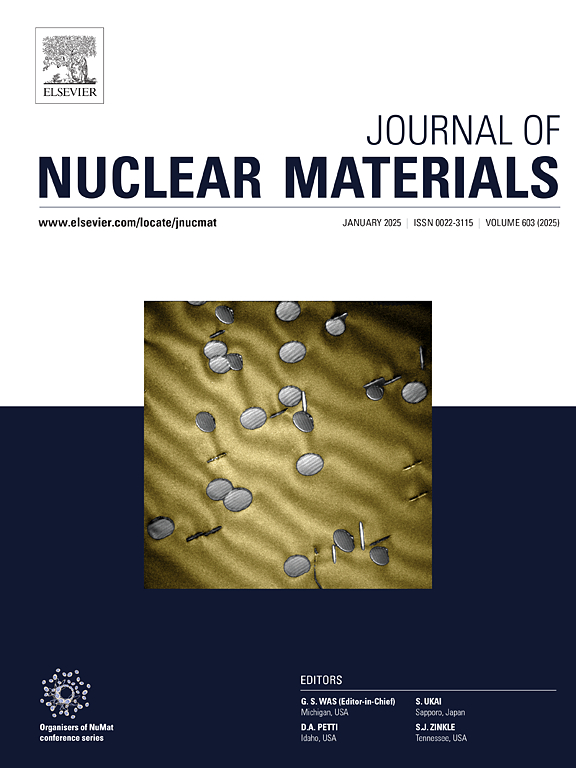单双束Fe和He离子辐照对NbMoTaW和Ti2ZrHfV0.5Mo0.2难熔高熵合金的影响
IF 3.2
2区 工程技术
Q3 MATERIALS SCIENCE, MULTIDISCIPLINARY
引用次数: 0
摘要
本研究比较了两种难熔高熵合金NbMoTaW和Ti₂ZrHfV0.5Mo0.2 (Nb RHEA和Ti RHEA)在单束Fe离子、单束He离子和双束辐照下的行为,重点研究了He气泡的演化、位错的产生和辐照硬化。微观表征表明,在单束和双束辐照下,Ti RHEA中的He气泡比Nb RHEA中的He气泡大。在双束辐照下,Fe离子注入引起的高原子位移(DPA)促进了He气泡的生长,导致两种RHEAs中的He气泡尺寸比单束辐照下的He气泡尺寸更大。两种RHEAs均表现出不同的位错演化行为。在单束离子辐照下,Nb RHEA的低DPA区形成了小而密集的位错环,而在高DPA区则形成了位错线网络。相反,在Ti RHEA中,只在损伤峰区观察到高密度的小位错环,而在前缘和衰减区没有观察到明显的辐照引起的位错环。在双光束照射下,观察到He团簇/He气泡在两个RHEAs中钉位错。纳米压痕结果表明,Nb - RHEA的硬化程度大于Ti - RHEA。Nb RHEA在单束He离子辐照下硬化程度最大,Ti RHEA在双束He离子辐照下硬化程度最大,这与两种合金中不同的位错演化行为有关。本文章由计算机程序翻译,如有差异,请以英文原文为准。
Effects of single and dual beam Fe and He ion irradiation on NbMoTaW and Ti2ZrHfV0.5Mo0.2 refractory high-entropy alloys
This study compared the behavior of two refractory high-entropy alloys (RHEAs), NbMoTaW and Ti₂ZrHfV0.5Mo0.2 (Nb RHEA and Ti RHEA), under single-beam Fe ion, single-beam He ion, and dual-beam irradiation, with a focus on He bubble evolution, dislocation generation, and irradiation hardening. Microscopic characterization revealed that, under both single-beam He ion and dual-beam irradiation, the size of He bubbles in Ti RHEA was larger than in Nb RHEA. Under dual-beam irradiation, the high displacement per atom (DPA) induced by Fe ion implantation promoted the growth of He bubbles, resulting in larger He bubble sizes in both RHEAs compared to those observed under single-beam He ion irradiation. The two RHEAs exhibited distinct dislocation evolution behaviors. Under single-beam ion irradiation, small, dense dislocation loops formed in the low DPA region, while dislocation line networks were observed in the high DPA region of Nb RHEA. Conversely, in Ti RHEA, high-density small dislocation loops were observed only in the damage peak region, while no evident irradiation-induced dislocation loops were observed in the front or attenuation regions. Under dual-beam irradiation, He clusters/He bubbles were observed to pin dislocations in both RHEAs. Nanoindentation results showed that the hardening of Nb RHEA was greater than in Ti RHEA. Nb RHEA exhibited the greatest hardening under single-beam He ion irradiation, while Ti RHEA exhibited the greatest hardening under dual-beam irradiation, which correlated with the distinct dislocation evolution behavior in the two alloys.
求助全文
通过发布文献求助,成功后即可免费获取论文全文。
去求助
来源期刊

Journal of Nuclear Materials
工程技术-材料科学:综合
CiteScore
5.70
自引率
25.80%
发文量
601
审稿时长
63 days
期刊介绍:
The Journal of Nuclear Materials publishes high quality papers in materials research for nuclear applications, primarily fission reactors, fusion reactors, and similar environments including radiation areas of charged particle accelerators. Both original research and critical review papers covering experimental, theoretical, and computational aspects of either fundamental or applied nature are welcome.
The breadth of the field is such that a wide range of processes and properties in the field of materials science and engineering is of interest to the readership, spanning atom-scale processes, microstructures, thermodynamics, mechanical properties, physical properties, and corrosion, for example.
Topics covered by JNM
Fission reactor materials, including fuels, cladding, core structures, pressure vessels, coolant interactions with materials, moderator and control components, fission product behavior.
Materials aspects of the entire fuel cycle.
Materials aspects of the actinides and their compounds.
Performance of nuclear waste materials; materials aspects of the immobilization of wastes.
Fusion reactor materials, including first walls, blankets, insulators and magnets.
Neutron and charged particle radiation effects in materials, including defects, transmutations, microstructures, phase changes and macroscopic properties.
Interaction of plasmas, ion beams, electron beams and electromagnetic radiation with materials relevant to nuclear systems.
 求助内容:
求助内容: 应助结果提醒方式:
应助结果提醒方式:


